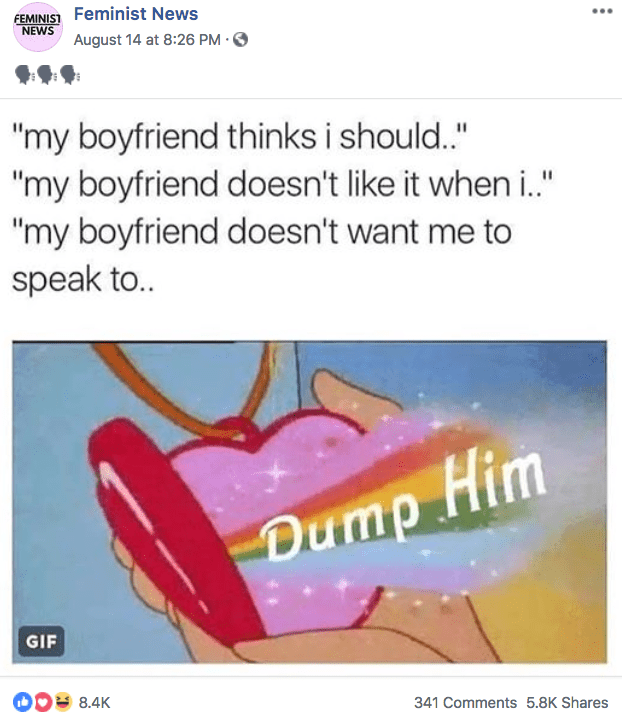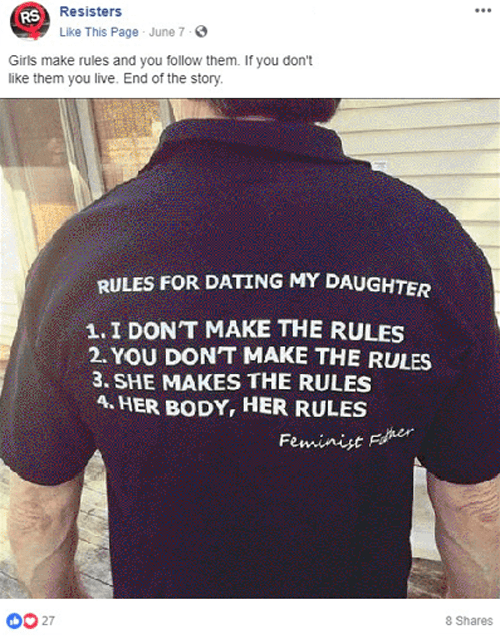Fake news. So what? Doesn’t everyone realize that all news is fake to some degree or another? Yet, we are supposed to get excited about it, because it is the reigning popular explanation for the spectacular failure of the American political system.
The way I see it, you see a political ad and you agree with it, or you don’t. How does this change your opinion, other than to reinforce it slightly in the direction it already was leaning? That’s how all advertising works, and it doesn’t matter if it’s from the Evil Russians or the Wonderful Democrats or the Heinous Lying Republicans.
We see the ad and confirmation bias kicks in if we agree with it and we get a little dose of happy recognition and… uh. So what.
The New York Times [failing establishment mouthpiece] has a quiz in which we are to distinguish fake ads from authentic fake ads:
 |
 |
Uh, who cares?
How about this pair: this pair is even harder!
 |
 |
It’s like asking “who is a bigger bloviator, Deepak Chopra, or Juval Hariri?” It’s the wrong question – neither of them is worth listening to. If you told me that one of the twain was a liar and a bloviator, I would say “so what?”
 |
 |
I have to admit I kind of like the “Make Tenochtitlan Great Again” meme in this one. I’m not a fan of ethno-nationalism in general but, seriously, it’s unfair how such a great civilization has been blown out of the limelight by the diseased and smelly rejects of Europe who invaded the Americas. You know the Europeans didn’t send their best people, right?
 |
 |
The establishment wants us to be very disturbed that their system for promoting their important messaging has been suborned. To them, since they paid so much for it, it’s a scandal; it’s a very big deal. Watch them squirm in terror as they are discovering that having a ton of campaign contributions from big companies (or the NRA) is a campaign liability. I can’t wait ’till someone in the DNC or RNC hits upon the idea of accusing the democratic socialist movement of being funded by Russia. Especially if they win.

By “reigning popular” I mean “what the media is talking about.” The media love talking about themselves, so any story-line in which the media plays a starring role – whether as a hero or villain – is going to get air-play.

I have a problem with the words “fake ads.” I don’t think it’s even possible to differentiate between a fake and an authentic advertisement. They are all the same.
The usage of political ads as examples somewhat clouds the whole discussion, so I’ll simplify it:
Option #1: Advertising one “correct” viewpoint is authentic, but advertising some different “wrong” viewpoint is fake. I doubt that, because then we’d get to the point where somebody could say, “Advertising coke is authentic, while advertising Pepsi is fake, because everybody knows that coke is the better drink.”
Option #2: Advertisements purchased by the good people (aka Americans) are authentic, but advertisements purchased by the bad people (Russian citizens) are fake. WTF? This is blatant discrimination.
Option #3: Ads that are clearly marked as ads are authentic, while ads that pretend to be something else rather than ads are fake. Well, we already have a term for this, here we aren’t talking about “fake ads,” but about “native advertisements.” And it’s not like the bad guys who promote some “wrong opinion” are the only ones who make native ads. Everybody does.
Option #4: Ads that honestly inform us about who paid for them are authentic, while fake ads are the ones that hide who actually commissioned and paid for them. This criterion is also problematic. Most of the time consumers and voters cannot know who donated money to whom, who truly stands behind which company.
Whatever consistent criteria I attempt to apply when trying to differentiate between fake and non fake ads, it always ends up looking ridiculous. The best definition for “fake ads” that I can think of is simply “any ads disliked by somebody who therefore decides to label them as ‘fake.’” There can be no objective criteria for dividing advertisements into “fake” and “non fake.” They are all the same.
By the way, the way I see it, freedom of speech means that everybody should be equally free to purchase advertisements regardless of whether they are Russian or American. Therefore this whole scandal is ridiculous.
OK, I took a look at the NYT site, and I get it (I’m pretty sure). The question is not exactly which is the fake ad, per se, but which is the fake site? One of the pictures/memes is calculated to produce a negative reaction towards the group who supposedly created and posted it. I think that the Huey Newton “ad” is funny, but I would never think that it would even have appeared on a Black Panther web site, much less an NAACP site. The psychedelic picture/meme plugs into anti-hippie prejudice, which cannot accept the fact that the anti-hippies won. The Tenochtitlan rising pic is definitely cool, probably found on a Make Mexico Great Again site. ;) But people who find Mexicans or American Indians a threat will probably find that one more threatening than the one that looks like it came from a middle school geography textbook.
To repeat myself, the question is not who actually made the site and the picture, but is the picture/meme meant to elicit a negative reaction towards the group that supposedly created it? That’s the kind of thing that fosters divisiveness.
Well, I went back to the NYT site and figured out how to find out what they thought. The supposedly feminist pics had puzzled me, and did not fit my theory. The “dump him” meme is divisive, but from an authentic feminist site, it seems. The “her rules” meme is not divisive, but the T-shirt has a definite patriarchal appeal, despite its verbal message.
Bill Spight @#2
Wow, I had no clue. None of these images produced a negative reaction for me.
#1: Both messages are reasonable. Of course a woman should dump a boyfriend who orders her around against her will. And she should also be the one who decides what “rules” she is comfortable with when it comes to dating.
#2: I don’t particularly care about either of the self-care messages, but none of them bothered me.
#3: The one about teaching kids to be businessmen makes sense, and I can agree with the message. The other one seems sort of pointless, and I didn’t really get the message, namely what exactly people suggest to do in order to achieve some elevation, but whatever; I assume it’s about improving the living conditions of people of color, so I’m fine with that.
#4: Both are about the fact that Native Americans did just fine before Europeans conquered them and destroyed their civilizations. And that’s a historical fact, there certainly were some flourishing civilizations in America before Europeans came there. The first one might suggest that Native Americans are trying to do something about their heritage and whatnot, but I certainly don’t see anything bad about that. In fact, it’s great if Native Americans are doing something in order to get organized and improve their living conditions.
Hmm, seems like I must have missed a lot of what these ads were supposed to tell due to me not being American and thus being less familiar with American culture. And what’s wrong with bright colors and hippies? If some people like the aesthetic and hippie lifestyle, whatever; everybody is free to choose for themselves how to live.
@#3
I failed to see any patriarchal appeal there. Instead I got the impression that it is about a father who loves his daughter and cares for her well-being and happiness. Which is perfectly fine, because parents certainly should wish for their kids’ well-being.
I must be awful with spotting these things.
I used to work at a small weekly paper (I was production manager) and saw some pretty crazy stuff. Let’s say that your paper is in a resort town where rich people go to spend money, and to vacation. There’s a new reporter in town who notices that gas prices in the Resort Town are much higher than they are in Farmer Town just a few miles down the road – so there is no excuse like, “It costs more because it’s farther to drive to deliver the gas” since it’s actually closer to the source. So then your new reporter takes photos and documents this and writes about it, and then the people who sell gas get really mad (because they just got caught cheating people) and threaten to withdraw all their ads, and then the owner gets really mad because this is hurting his bottom line and he won’t make quite as much of a killing as he normally does if all the gas stations pull their ads. Usually the reporter gets fired. (Although I did once see *another* reporter, who the owner did not like, get fired for what a different reporter wrote.) The big message to everyone left is: Write about the junior prom, or the Lady’s Gardening Club instead. Keep your head down, don’t make waves, or you will lose your job. In the meantime the gas station owners can cheerfully go on gauging the people who live in Resort Town and the owner of the paper can cheerfully go on building up his 401K, because now no one has any way to find out about the gas gauging, or anything else of value for that matter.
I don’t really know what the answer would be (not base our economy on money?) but there has *always* been a problem with reporters and what they report, and what is and is not allowed to be reported on. And sure, I understand advertising: heck, I have to advertise myself because no one else is going to do it, and it’s sure hard to sell stuff I make without advertising. But good grief I don’t think EVERYTHING has to be an advertisement yet that’s what it looks like, more and more.
TBH, I was looking at the image that says “Dump Him”, and trying to think of continuations of those sentences that would (probably) not be problematic (or would be problematic for opposing them?)
“My boyfriend thinks I should . . .” be more compassionate to rape victims.
“My boyfriend doesn’t like it when I . . .” mock male rape victims.
“My boyfriend doesn’t want me to speak to . . .” his father, who he says raped him.
“One of the pictures/memes is calculated to produce a negative reaction towards the group who supposedly created and posted it.”
#1 – Both ads resonated very positively with me. “Dump him” is advise I’ve given on occasion to female friends of mine who were clearly in relationships that were not in their interest (varying from abusive, to overly controlling, to just bad.) The T-shirt reminded me of meeting my (now ex) girlfriend’s grandfather for the first time, who told me that “if I ever hurt his granddaughter in any way, he’d come for me”. Grandpa was 93 and confined to a wheelchair at the time, but I thought it was incredibly cool he’d stick up for her like that and I meekly promised I’d behave.
#2 – Huh? Both pretty much meaningless, except as a teacher “unlearning” things resonates off to me.
#3 – Black elevation: Eh? Okay? Black Excellence: sounds good! (Although the mismatched quotation marks do disturb me…)
#4 – Aztlan: this is a joke right? Aztec: Sounds like someone’s advertising a tourist trap for suckers?
I’m not sure if ‘confused’ is the intended negative reaction?
Fake news can include (but is not limited to) fake attributions.
Look at each of the examples at hand, and tell me truthfully they constitute ‘news’ rather than particular opinions.
(Yeah, I know; ‘news’ is being used as a synecdoche for ‘media’)
—
Ieva, the patriarchal aspect you miss is that it is the authority of the dad that establishes the relationship status. It ain’t a sentiment expressed without context.
[‘media’ → ‘media content’ above. Sloppy]
re context:
See the image.
Burly, veiny and broad-shouldered. Ambiguous pose. Nice sentiment.
But. Not gonna follow his rules? Expect pain.
(Not that I’m much at semiotics, but the bleeding obvious does get through)
1. Most of these are not advertisements in the traditional sense. I think “posts” (or, more precisely, “social media posts”) would be a better way to describe them.
2. As Bill points out in the second comment, the article is not about distinguishing between “fake” and “real” ads or posts (whatever that might mean), but between fake and real accounts. Unlike the former, the latter has a fairly clear definition: a person or group that really is what they claim to be. (Yeah, there’s some arm-waving there, but you get what I mean.)
3. Maybe kind of a side thing, but the only one I missed and it looks like others are missing it to: for the first one, with the picture of the t-shirt, the important part is not what’s written on the shirt but what’s written above the photograph. (It’s not terribly readable here, but on the original site, if you don’t skip over that text as I did, that’s the easiest fake account to identify.) I think that Bill (and others) missed this.
4. Bill gets the core of it, in the same post: “…is the picture/meme meant to elicit a negative reaction towards the group that supposedly created it? That’s the kind of thing that fosters divisiveness.” If you find yourself saying, “None of these images produced a negative reaction for me,” consider whether you’re the target audience or not. They’re not trying to convert liberals to conservatives; they’re trying to make conservatives be less willing to work with liberals.
These are pretty subtle, but if you’re dismissing these as not effective, I think that may well make you taken in by them.
Fake News works because it appeals to the (tribal) prejudices of the population(s). The most strongly defined tribal elements are based on classism, racism, and personal prejudice, so fake news that stirs up the Trumpalos is the most effective.
Curt Sampson @#12
The difference between advertisements and social media posts has gotten pretty murky by now. If social media are used as a platform for advertising and social media posts are used to promote something, then aren’t those advertisements?
True, here defining each and differentiating between both is possible. But the thing is, I just don’t care about whether some social media account is real or fake, whether the person behind the account really is who they claim to be.
I understand your point, but I’m still going to dismiss these as not effective. Among activists there are various very different people. Some of them try to be approachable for those who disagree with them, they try to avoid confrontation and make their messages as non-threatening and palatable as possible for their ideological opponents. Then there are also activists who are the exact opposite: they are confrontational, bold with their messages, provocative, and they don’t hesitate to make their ideological opponents hate them. What these fake social media posts did was basically mimicking exactly the same thing as what the second type of activists are already doing.
The underlying problem here is misrepresentation of somebody else’s position. Misrepresentation of something is basically the whole point of ads. Misrepresentation and strawman arguments are happening all over the place. I don’t see how fake social media posts are any worse than all other ways how misrepresentation happens all the time.
This is a conversation I had a few years ago with a German student who was a Muslim (both of us were studying in the same university at the time).
Her: I don’t like atheist activists. There was this nasty guy who claimed that all believers ought to be converted to atheism.
Me: This guy? Don’t you even remember the name? Richard Dawkins, maybe? He’s among the most famous atheist activists.
Her: Yes, that’s right. I don’t like him.
Me: So, have you read any of Dawkins’ books?
Her: No, I haven’t read any. I just heard from another Muslim that Dawkins said this thing, and that’s bad.
In this case my acquaintance’s opinion wasn’t distorted by some religious Dawkins’ impersonator who had intentionally pretended to be an atheist in an attempt to make atheists look bad. Instead it was just another believer who told her, “An atheist activist has said this.” This is basically some good old fashioned misrepresentation. I don’t exactly see how social media posts where somebody pretends to be somebody else in an attempt to make some group look bad are any worse than all those other ways how people misrepresent and distort the opinions of those they disagree with.